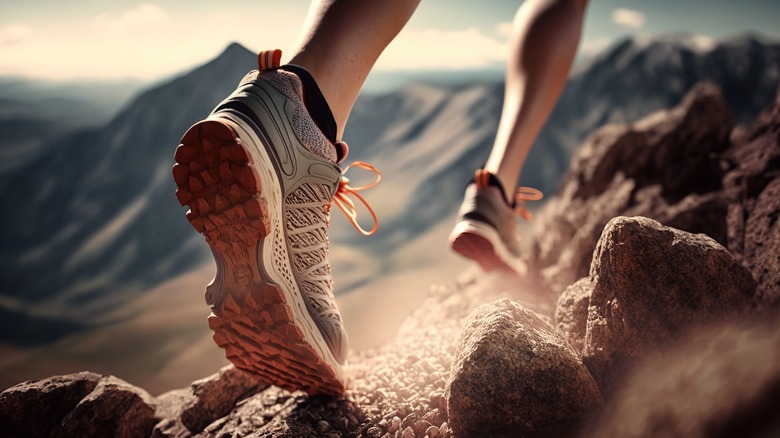Choosing the best hiking footwear
Whether you’re exploring the backcountry or navigating well-traveled trails, your feet get you where you’re going. The last thing you want is to be stuck out in the middle of nowhere with painful, injured feet because you underestimated the importance of choosing the proper footwear for hiking. Blisters and toe injuries are common among hikers and can rapidly sabotage your experience. If they’re serious enough, they can even impede your ability to make it back safely.
According to Eric Hanson from Backpacking TV, it’s important to consider where you’ll be hiking when choosing footwear. Hanson says Gore-Tex is an excellent tool for keeping feet dry if you anticipate hiking through rain, mud, or snow. But if you’re hiking in a hot or dry climate, the breathability of a running or trail shoe — something Gore-Tex doesn’t offer — is more important. If you’re unsure or it’s “shoulder” season, Hanson says it’s best to “err on the side of Gore-Tex.”
Choosing a good set of moisture-wicking socks
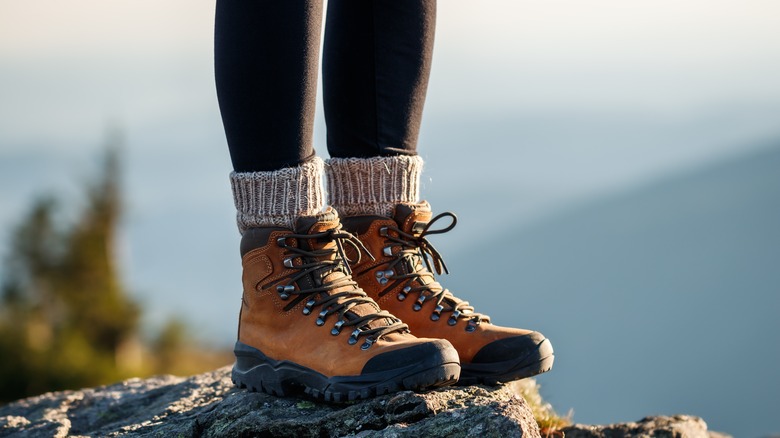
Choosing the right hiking socks can also be key to how well your feet hold up after hours on the trail. Wet socks can create friction, rubbing against your feet and causing some ugly blisters that only get worse until you’re out of those shoes and shocks. Peruse a few backpacking forums, and you’ll notice many experienced hikers swear by adding liner socks to their hiking gear. For those not in the know, liner socks are super-thin, moisture-wicking socks worn under regular hiking socks.
In one Backpacking Light thread, several hikers insisted thin polyester liner socks are the key to avoiding blisters. One experienced hiker with the username Hiking Malto recommended wearing liners anytime you plan to wear midweight shoes while emphasizing, “But if you hike somewhere with heat then sweaty feet will not be your friend.”
For your main hiking sock, a crew-height sock is highly recommended for most hiking. You should always consider the temperature you’ll be hiking in when deciding on the amount of cushion you’ll need — for warm-weather hiking, pick a thinner-cushioned sock. Merino wool and polyester are good choices for moisture-wicking socks. And it’s also essential to ensure your socks are a good fit for your feet.
Picking out the right jacket
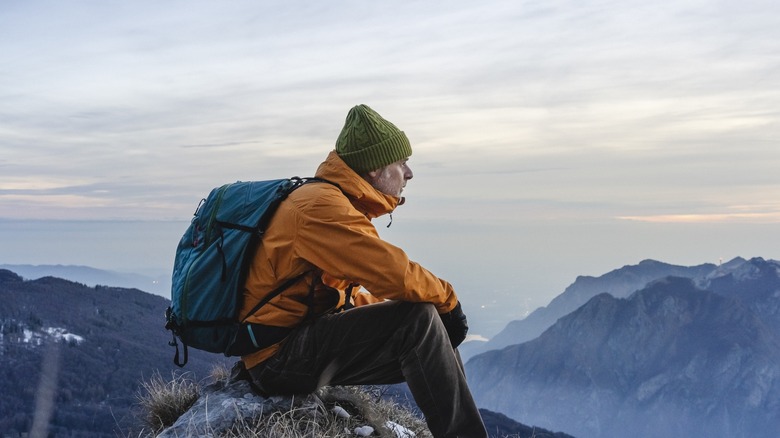
Deimagine/Getty
Anytime you’re hiking, there’s a chance the weather could shift at a moment’s notice, bringing with it a biting breeze or a midday drizzle. That’s why not just any old hoodie will do when you’re out on the trail. Much like your footwear, you’ve got to find a happy medium between breathability and weatherproofing. A good hiking jacket will be water-repellant enough to keep out light rain and protect you from the chilly winds you might encounter. At the same time, you need something you can work up a sweat in without getting overheated.
If the weather is reasonably warm and you’re looking for something lightweight enough to fit neatly in your hiking pack without being cumbersome, a windbreaker is your best bet. While they’re not waterproof, they generally come with some degree of water resistance, and they’re relatively compact when packed up. If you’re going to be hitting colder temperatures, you’ll need to add some layers and insulation.
Selecting the right hiking pack
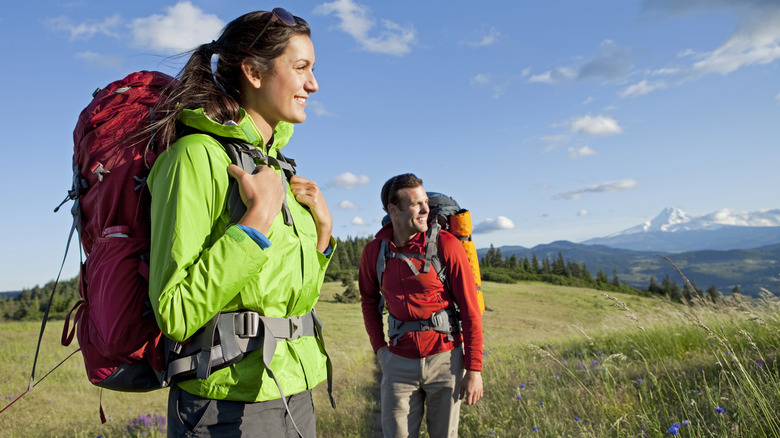
Jordan Siemens/Getty Images
The size and comfort of your hiking pack are among the most important decisions you’ll make when picking out hiking gear. In many ways, the size of the pack you invest in is a matter of personal preference. Hikers who like to err on the side of comfort, packing plenty of food, water, and extra gear, might be okay with a little extra weight to their packs. For those who prefer to make good time and hit the trails a little harder, it might be better to go ultralight. Likewise, day hikers can get by with a smaller pack volume, but if you’re planning a more extended trip, you’ll need a larger capacity pack.
You’ll also need to consider your torso length when choosing a pack. Some packs are better for women or younger hikers, so be sure to check out your options. If you’ve got a smaller waist, you might need to purchase a smaller hip belt than comes standard with your pack.
Picking out a trustworthy compass
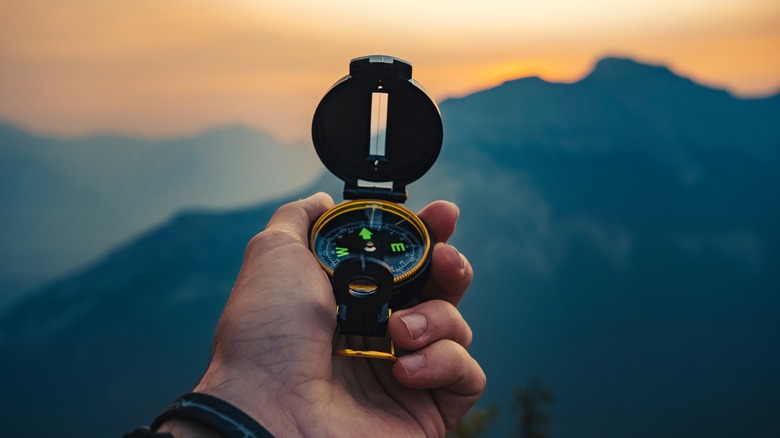
Joshua Woroniecki/Shutterstock
Having a reliable compass on hand is essential to finding your way, especially if you end up getting turned around or lose track of the sun or other navigational landmarks. Erik Kulick, founder of True North Wilderness Survival School, believes the ability to navigate is an essential skill for anyone who plans to spend time in the great outdoors. “Not only will this help you to get the most out of your next outdoor adventure, but you’ll do so more effectively, safely, and definitely, with more confidence,” Kulick emphasized.
But how hard can it be to choose the right compass when its primary function is to point north? As it turns out, compasses can vary in both their capabilities and quality level, and the last thing you need is a dodgy compass when you’re miles deep on a hike.
For beginners, an orienteering compass with a base plate makes it easy to find and set points on a map. A compass with a cover helps keep a set bearing and allows for triangulation. For more experienced compass users, a lensatic compass is a military-style compass with a sighted lens and luminous details for nighttime navigation. Whichever style you land on, Kulick suggests going with a proven manufacturer and spending a little more on a quality product.
Choosing a quality GPS device
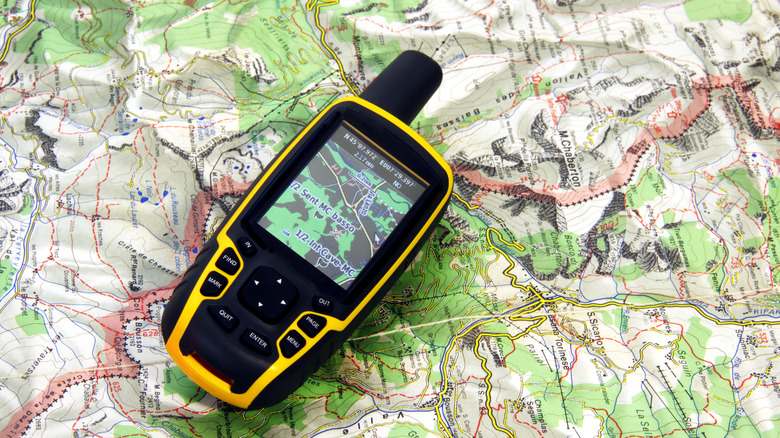
Eureka_89/Getty Images
Since most of us have GPS on our phones these days, you might be wondering whether you need to invest in a GPS device at all. But handheld GPS devices designed for outdoor use are built to be sturdy and durable, something your phone isn’t. They also tend to get excellent satellite reception when you’re deep in the backwoods, which makes them a lot more reliable than your phone service if you’re lost.
But much like choosing a new phone, looking over GPS device features can leave some shoppers feeling overwhelmed. Since pricing generally means add-on features, if you only need GPS, a lower-priced option should be fine. Add-ons like an altimeter, barometer, and electronic compass are just some of the extra features you can get with spendier models. Some even come with built-in digital cameras and satellite messenger capabilities so you can get help in an emergency.
Purchasing a whistle or other noisemaking tool
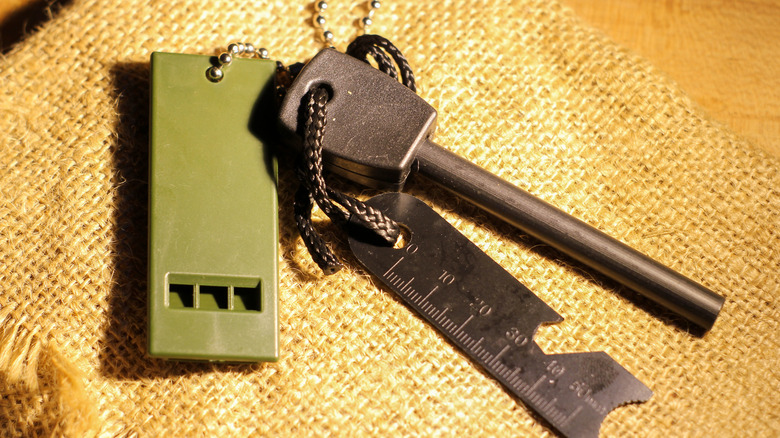
Nopember30/Getty Images
If you’re ever in trouble and need to call for help, you’ll need a good whistle since the sound of one can carry much farther than your voice. A whistle can also be helpful when communicating with other members of your camping party from a distance.
Most traditional whistles come with what’s called a “pea” inside — that’s the tiny ball you can hear rattling around in it. In a whistle discussion subReddit on r/Survival breaking down whistle design, many experienced whistle users recommended against whistles with peas in them. As u/XELBRUJOX observed, “A pea doesn’t work well when wet, and will not work at all if frozen.” You also want something bright enough in color that it contrasts the ground if you drop it.
You also want a whistle designed especially for survival — ideally, one capable of producing 110 decibels or more. Since a whistle that loud can temporarily deafen you to the sound of rescue or danger, you’ll need to cover your ears when using it, so be sure your whistle is light enough that you can use it hands-free.
Choosing the right multitool
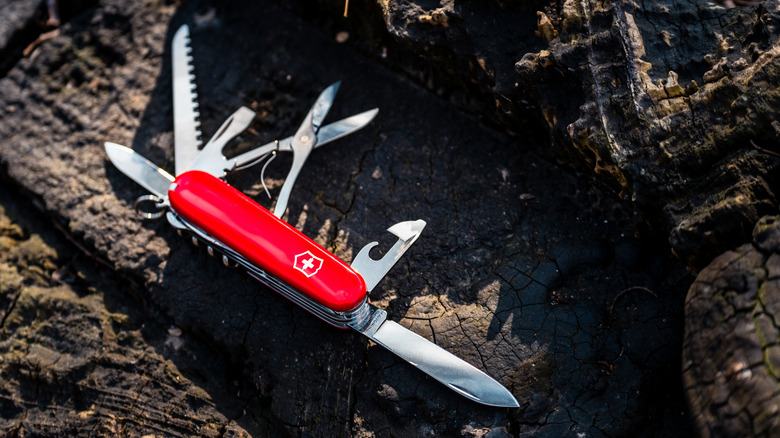
Panwasin seemala/Shutterstock
You also want to make sure you’ve got a good multitool in your bag, even if you’re only out for a day hike. You’ll be surprised at how often you can end up using one when you’re exploring the wilderness. Much like choosing a pack, the best multitool for your needs will depend on how long you plan to be out there.
If you’re on a short hike, a lightweight tool should serve you just fine. But if you’re hiking with a small multitool, consider choosing one that clips to your pack or belt, so it’s easier to keep track of. On the other hand, if you plan to do any camping and want to use the multitool, you might want to invest in a heftier tool. You can also pay more for locking mechanisms and anti-corrosive metals, so be sure to check out all of the features when you’re shopping.
Selecting a good set of trekking poles
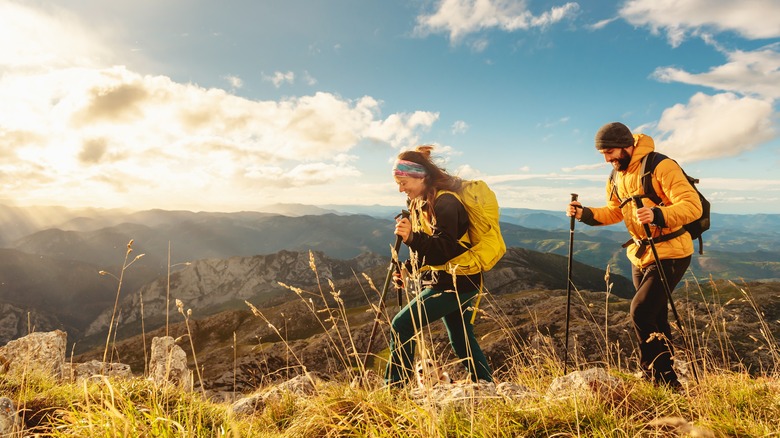
Alberto Menendez Cervero/Shutterstock
If you’re relatively new to hiking, you might be unclear whether you need to purchase trekking poles. Also called hiking poles, these handy tools are a walking aid generally used to help traverse tricky terrain. They’re especially helpful when you’ve got a lot of weight on your back, which can make walking on uneven ground much more challenging — not to mention potentially painful. An alternative is a hiking staff, which is essentially a single trekking pole.
Trekking poles are also good for crossing streams, hiking slippery or snowy terrain, and keeping your balance when you’re heading up or down a steep incline. They’re also good for pushing poison plants out of the way without touching them.
The best trekking poles will be lightweight but contain some shock absorption properties; aluminum and carbon fiber are your best bets. Shock absorbers, steel tips, and foam or cork grips are also good things to look for. Finally, be sure to buy your poles in person and get help with sizing them to your height so your elbows are at the right angles when using them.
What to look for in a headlamp
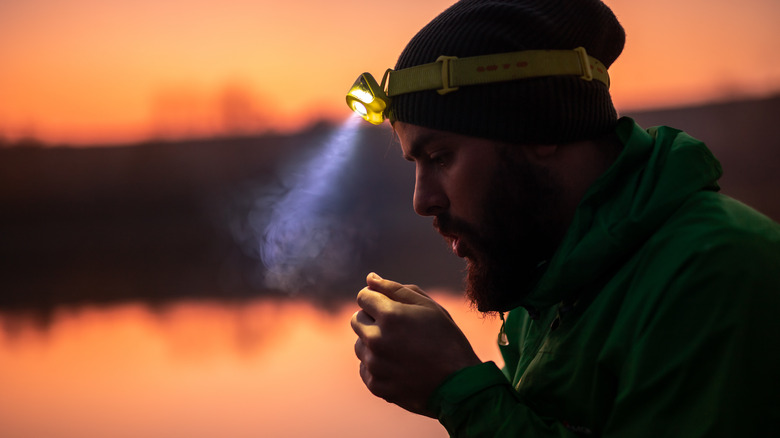
Max kegfire/Shutterstock
If you should find yourself out after dark, having to handle a flashlight can tie up your hands. This can make it particularly challenging if you need to use navigational tools, look through your pack, or set up an emergency shelter. That’s why you should always choose a headlamp over a flashlight, and you might be surprised to see how many options there are when buying one.
When choosing which headlamp you want to invest in, take a look at the lumens and distance the light casts. Trails in the deep woods can get pretty dark once night falls, increasing the chance that you could become injured or take a wrong turn. You’ll want a headlamp that’s bright enough and casts its light far enough so you can see well ahead of you on the trail. Be sure to pack enough batteries to use yours for as long as needed.
The right water purification system could save your life
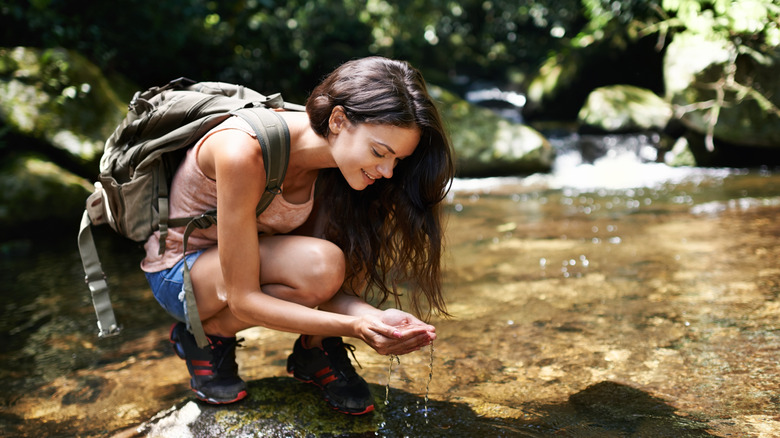
Peopleimages/Getty Images
Experienced mountain climber Chase Tucker of the YouTube channel Chase Mountains insists that inexperienced hikers can often misjudge how much water they’ll need on a hike. But even if you plan on hiking near water sources like a stream or spring, it’s not necessarily a good idea to drink up. As Tucker warned, “It’s not always going to be safe. Water in the mountains might seem like it’s pristine and clear,” but it might not be. Waterborne parasites, bacteria, and other harmful microbes are all risks you take by drinking unfiltered water.
That’s why it’s crucial to pack a water filter or purifier wherever you plan to hike. A purifier and filter will filter out impurities while also chemically treating the water. If you know there’s water where you’re heading, filtering or purifying water also allows hikers to reduce the weight they need to carry, increasing speed and stamina on the trail. Tucker prefers a soft-side bottle with a built-in filter, but you can also pick up water-purifying tablets or smaller filters like LifeStraw.
Buying an emergency shelter
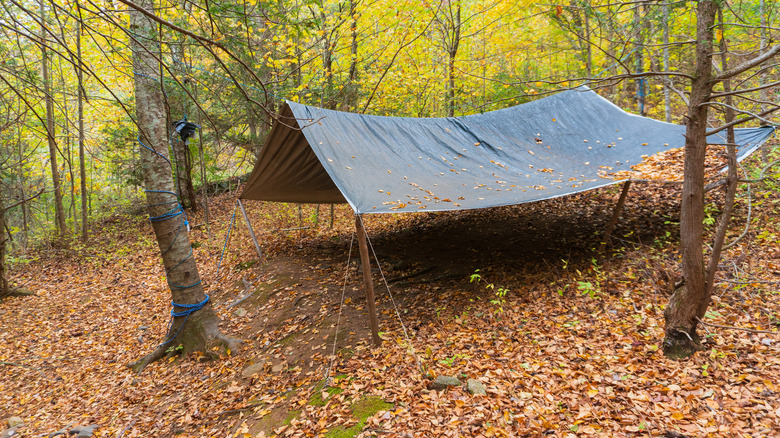
James Mahan/Getty Images
If you plan to be spending any time in the backcountry, you should seriously consider taking an emergency shelter along with you. Posting in the subReddit r/Ultralight, hiker u/seeking_hope shared the backcountry close call that caused them to add an emergency shelter to their pack. “I got lost while hiking this weekend and had to be rescued by SAR,” the poster warned. Worse, they’d dropped their compass, causing them to get hopelessly lost.
Despite their reluctance to add more weight, the poster recounted watching a storm roll in with no shelter on hand. “I was shivering so much and couldn’t get my pup warm either,” they said. Using their remaining 3% phone battery to call search and rescue likely saved their life, but some hikers aren’t so lucky.
Several manufacturers make extremely lightweight emergency shelters you can easily throw in your backpack in case you get lost on your hike. Or consider investing in an emergency bivy sack — a type of sleeping bag that serves as an emergency shelter that completely protects against the elements and weighs only a few ounces.
Choosing a reliable firestarting tool
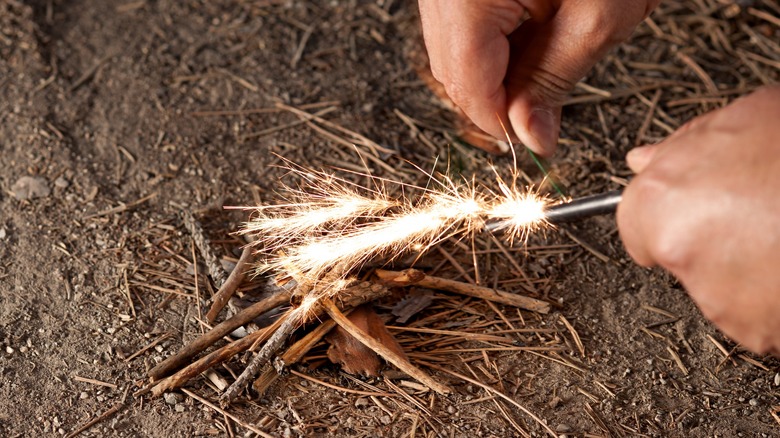
Lebazele/Getty
If you do end up in an emergency situation, you should be capable of starting a fire if you have to. And you want to rely on something other than your lucky Zippo if you’re stranded in the wilderness in sub-freezing temperatures with rain drizzling all around you. Particularly if you’re planning to be hiking at elevation, it’s a good idea to stash a fire starter in your bag — and make sure you’re comfortable using it before you get into a survival scenario.
There are a few different types of fire starters available. One of the more affordable is firesteel, also called ferro rods or ferrocerium. These create a spark when struck against a knife blade or striker included with the purchase. Magnesium fire starters work similarly and are another affordable option, although ferro rods are a little easier to strike up. Whatever you choose, be sure to test it out before you’re forced to use it for real.
Make sure you’ve got a good first aid kit
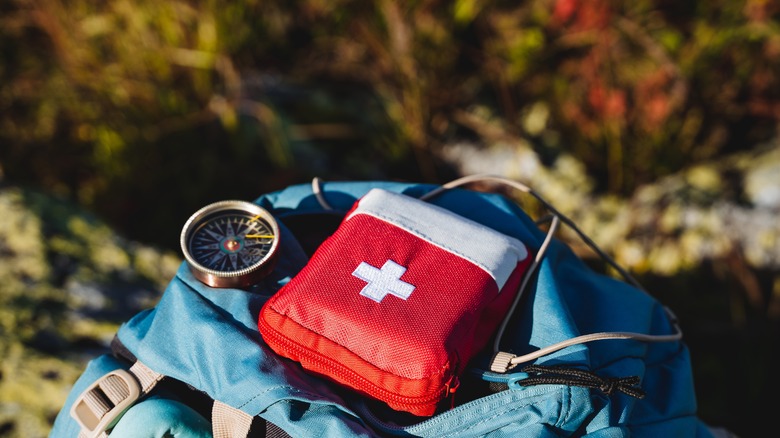
Aleksey Matrenin/Shutterstock
Anytime you’re going to be in the wilderness, you need to have an excellent first aid kit with you. Blisters, sprained ankles, and insect stings can all put a damper on your hike, and having a well-stocked first aid kit in your pack can make all the difference. You can pick up a basic pre-packaged first aid kit at most sporting goods stores. It’s also a good idea to add a few things so you’ve got most emergencies covered if you’re planning on doing any serious hiking.
At the bare minimum, ensure you’ve got something for insect stings, an assortment of bandages, hand sanitizer, gauze pads, medical tape, a pain reliever, an antihistamine, and a few other basics. You also want to include first aid cards to help guide you through any emergencies you’re not experienced with handling. Don’t forget to stock any prescription medications you might need, including asthma medications or an EpiPen.

